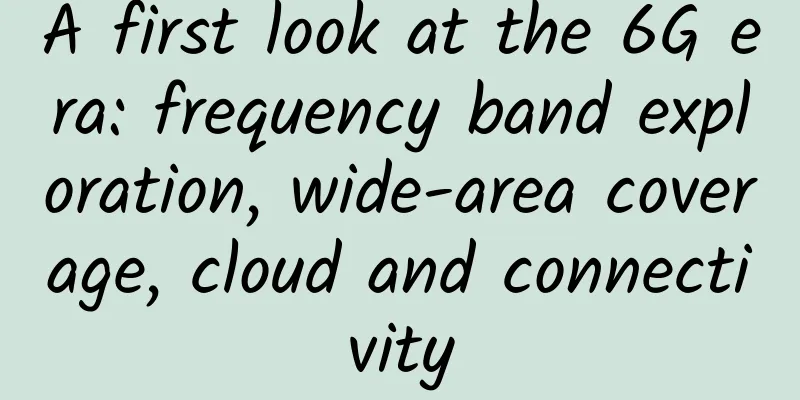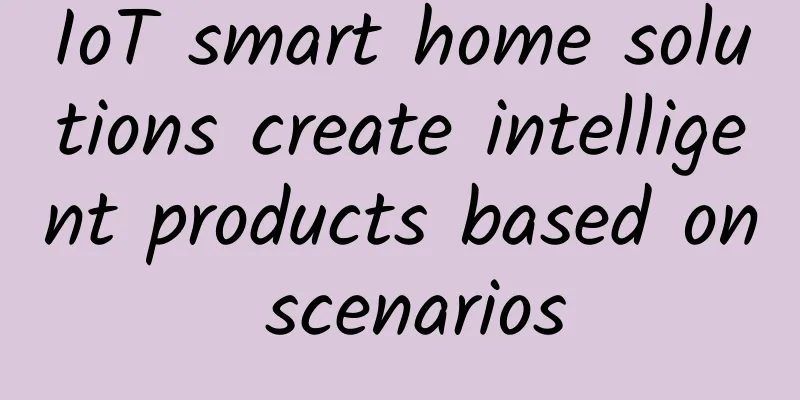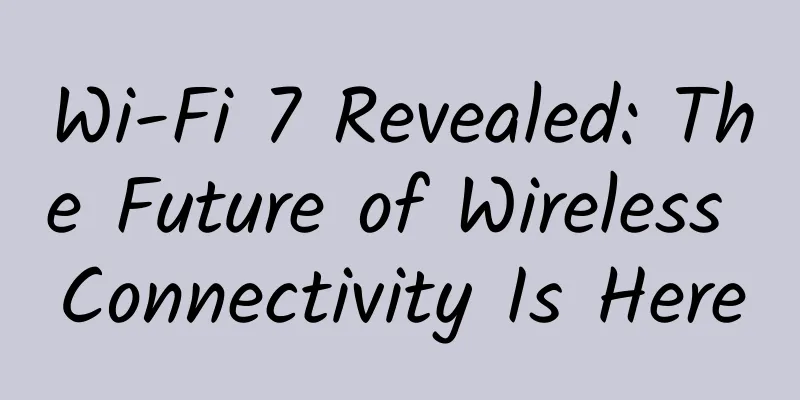A first look at the 6G era: frequency band exploration, wide-area coverage, cloud and connectivity

|
When 5G R16 and R17 have not yet been launched, calls for 6G have been rising one after another. On the one hand, it may be because the communications industry likes to constantly look to the future. On the other hand, it may also be because people subconsciously believe that the double number is the official version of the creed. Although 3GPP plans to start 6G research in 2023 and standardize 6G in the second half of 2025, many companies have already started 6G research and envisioned the vision of 6G on different occasions, which means that we can already get a glimpse of 6G.
Frequency band explorationIn the 5G era, the communications industry has begun exploring frequency bands. Frequency bands are no longer limited to Sub-6GHz, and have begun to use millimeter wave bands with richer resources to achieve higher speeds and lower latency, thereby achieving 5G's 10Gbps or even 20Gbps peak rates. 6G will further explore higher frequency bands. In addition to the millimeter wave band currently being used in 5G, terahertz has been widely mentioned. However, the technical difficulties that come with it are also imaginable. Due to the higher frequency, the coverage range of a single base station may be only more than 100 meters, and the signal penetration ability is certainly more limited, which means that the density of base stations will be greater, and it will be more difficult to achieve continuous coverage. Since terahertz is used, joint processing methods such as source-channel joint coding and voice and communication combination also need to be solved. The industry has begun to expect that full-duplex technology will be used in the 6G era, saying goodbye to the current separation of time, frequency, and space, and achieving the same frequency band and the same resources. The antenna problem will undoubtedly become more complicated. The frequency band combination of 5G equipment has increased exponentially, and it will definitely increase several times after adding terahertz. In addition to terahertz, satellite communications have also been considered in 6G networks. Recent news has shown that Apple iPhone will support low-orbit satellite communication capabilities in subsequent products. SpaceX also submitted documents to the Federal Communications Commission (FCC) of the United States, showing that it is preparing to launch nearly 1,300 Starlink satellites within 6 months. This is undoubtedly laying the groundwork for the 6G era. The introduction of satellite communication capabilities will also solve the coverage problem in the previous cellular communication era. Multi-dimensional coverageAt present, 5G ground cellular systems cover less than 10% of the earth's surface, specifically about 7%, while 6G actually aims to achieve integrated coverage of the air, land, and sea. The purpose of Starlink launching a large number of satellites is to achieve full coverage. In fact, there are a lot of signal blind spots in the current production and living areas. For example, in the Arctic region where scientific research activities are concentrated, communication can only rely on the Iridium system, and there is a huge demand for high-bandwidth network coverage. Similarly, in many coastal routes, there is no cellular network coverage, and there are a lot of broadband coverage blind spots. Satellite communications will undoubtedly solve this problem. However, if wide-area coverage is achieved through satellites, there is also the question of whether the service quality can be guaranteed, and there is a tendency for uneven business distribution. The cost of low-orbit satellites of the scale of StarLink is still too high, and the scale-for-capacity design still results in a low cost-effectiveness ratio. High-orbit satellites have problems with backhaul delays and insufficient high-orbit resources. At the same time, the launch of a large number of satellites into space also raises the issue of environmental protection. Astronomers are currently experiencing interference from satellites in their observations of natural celestial bodies. With the continued launch of larger-scale satellites, it will be even more difficult for astronomers to understand the world of outer space. As satellites reach the end of their service life in the future, there will also be a huge problem of space junk. In addition to solving the problem of wide-area coverage, deep coverage is also needed, which aims to eliminate blind spots, improve the coverage capability of weak coverage areas and the user's communication experience. In order to achieve ubiquitous intelligent communication, the 6G system will require a deep coverage rate of nearly 100%. In addition, the status of artificial intelligence will become even more important. It is expected that it will pave the way for 6G starting from R18. An important point is that artificial intelligence will play a role in base stations. The industry will design end-to-end wireless systems driven by data, realize air interface design with machine learning capabilities, and dynamically optimize the performance and efficiency of wireless systems, such as dynamic air interface adaptation, joint training across networks and terminals, model sharing and distributed reasoning. The 6G era will undoubtedly move towards the goal of having networks everywhere, in the sky, in the sea, and underground. Cloud and Connectivity5G is undoubtedly moving towards the vision of the Internet of Things. A large number of industrial equipment and instruments in daily life will have the ability to connect. Of course, there are still cost problems in the promotion of vertical industries. On the one hand, the application parties believe that the cost of communication modules is high and it will cost more after large-scale application. On the other hand, module manufacturers have been surviving on small profits for many years. If you want to lower the price, it is probably not an easy problem to solve. However, in the 6G era, every grain of sand must be connected to the network. It is impossible to install a module on the sand, but at least every shovel may have the ability to connect. But this is undoubtedly a huge cost issue. At least the cost of 5G modules is still unresolved. If the 6G era needs to support more frequency bands and make room through more advanced processes to put it in the "shovel", then I am afraid that not everyone can afford such a "shovel". Maybe the signal has achieved full coverage, but the problem of the digital divide will be stuck in money. The connection of everything will make the cloud even more important. The systems in everyone's handheld terminals will be fully cloud-based, and work and entertainment will rely more on the cloud. Perhaps by then, connectivity will be more important than local computing power. This also means that security will become more important. How to desensitize data, how to protect privacy, and whether the cloud will steal will become more serious issues. |
<<: 5G private network, analyzing the strategic layout of the three major operators
>>: 18 pictures tell you: 10 key technical points that a 90-point network engineer should master
Recommend
Digital currency: Don’t be fooled by the “blockchain” cover
Since the beginning of this year, the digital cur...
IPv4 addresses are exhausted. Let’s discuss IPv6 penetration and IP migration complexity.
[[283967]] As a basic resource, IPv4 has supporte...
Byte side: Can TCP and UDP use the same port number?
Hello, everyone, I am amazing. Today I saw an int...
edgeNAT September Promotion: 20% off for monthly VPS and 30% off for annual VPS starting from 48 yuan/month, in the US/Hong Kong/Korea data centers
edgeNAT has launched a promotional event for the ...
The management and configuration of routers and switches will definitely refresh your mind!!!
1. Management and configuration of routers and sw...
How the wireless network market will develop in 2022
A wireless network is a computer network that re...
There are four misunderstandings about network intelligence
If you don't talk about AI after dinner, you ...
5G to B development requires strategic patience
After more than two years of development, 5G has ...
Sharktech: $59/month 1Gbps unlimited traffic server, E3-1270v2/16GB/500G SSD/Los Angeles high defense
Sharktech's two promotional machines this mon...
The IPv6 in-depth promotion meeting was held in Beijing. Why does China want to promote IPv6 "desperately"?
Recently, the "Conference on Deepening the I...
Wi-Fi 6 is here: These 12 questions will clarify it for you
5G is here, and WiFi 6 is here too. Everyone has ...
In addition to being faster than 4G, what other secrets does 5G have that you don’t know?
With 2020 behind us and looking ahead to 2021, we...
Global semiconductor industry capital expenditure will reach nearly $150 billion in 2021
[[426618]] On the 29th, the Semiconductor Industr...
As 5G price war begins, US operators also adopt "Internet thinking"
After taking the lead in the world in 5G network ...
Share | Basic knowledge of 5G wireless network
Wireless networks have improved dramatically over...









